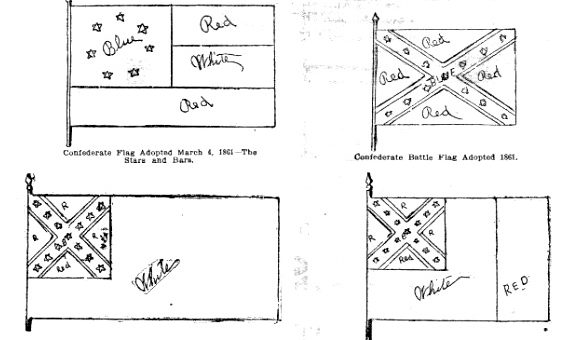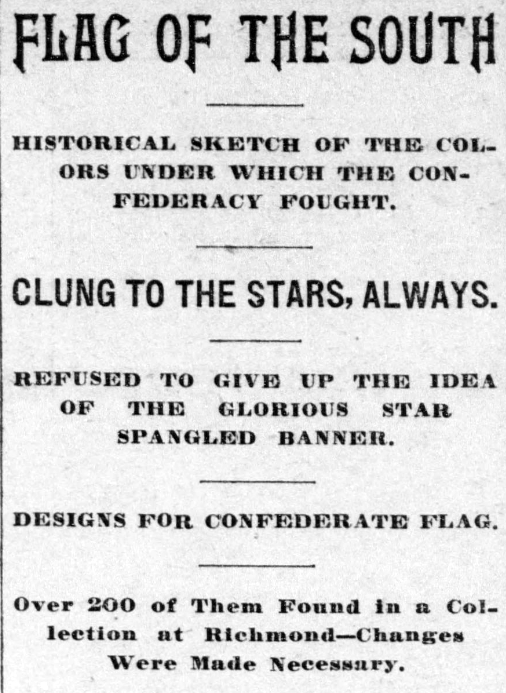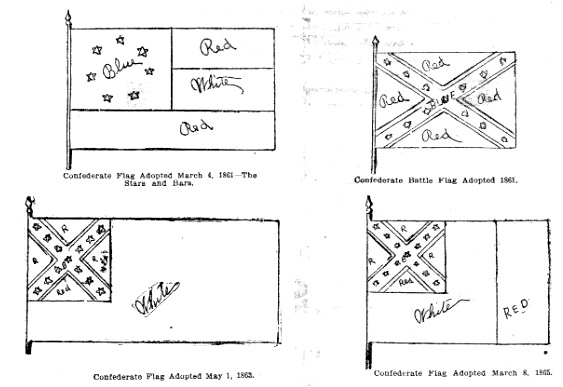
A brief look into the design(s) of the Confederate flag shows that there were originally over 200 different designs sketched out to represent the Confederacy.
Numerous stories have been published about the origin and designs of the confederate flag. Here are a few:

The Confederate Flag
(Article published in 1903.)
R.T. Beauregard, of New Orleans, La., gives the following account of the design of the confederate flag:
“During the battle of Manassas, Gen. Beauregard had observed the difficulty of distinguishing his own from the enemy’s colors, and, in order to prevent all error in the future, had determined to adopt in his army a battle flag distinct in color and design. He, at first, sought to procure a change in the confederate flag itself, and Col. W.P. Miles, then chairman of the house military committee, had caused, at his request, a repor to be presented to that effect, but with no result. In a conference between the (then) three senior officers, at Fairfax Court House, in September, one of four designs for a battle flag, one presented by Gen. Beauregard, was adopted. It was a red field with a diagonal blue cross, the latter edged with white and bearing white stars. To render it more portable it was made square, instead of oblong, by order of Gen. Johnson.
“This beautiful design, by a strange coincidence, had been previously devised by Col. Miles and recommended for the confederate flag to congress, then in session at Montgomery, in March, 1861. It had also been proposed by Mr. Edward C. Hancock, at the request of Col. James B. Walton, at New Orleans in the month of April. It had been offered by Col. Miles to Gen. Beauregard in substitution for one nearly similar in emblem and pattern, but different in the distribution of colors suggested to him by Gen. Beauregard when the latter was seeking to procure a change in the confederate flag. And it was now proposed anew to the general by Col. Walton, who had Mr. Hancock’s design.

“Thus, it will be seen that the design of the confederate battle flag was conceived and drawn long before a union soldier had tried his skill in water colors on an original which was not and could never have reached the hands of the general’s lamented daughter. For she was a little girl who was in Louisiana during the whole of our unfortunate war, and was seen by her father only at its close.”
Source: Williston graphic. (Williston, Williams County, N.D.), 07 May 1903.
The Confederate Flag
The first Confederate flag consisted of “stars and bars,” and was adopted by the Confederate Congress at Montgomery, Alabama, March 4, 1861.
The Confederate “National flag” was adopted by the Confederate States May 1, 1863.
In the battle of Manassas, the Confederates had almost been defeated when Gen. Beauregard saw an army coming. He could not tell whether they were Confederates or Federals, but soon saw that they bore the Confederate flag. The coming of that army put fresh courage into the hearts of the Confederates. On this battle field Gen. Beauregard decided that the Confederates should have a flag that could be easily distinguished from that of the foe; so he said let the ground be red, the stars white, and the bars blue. The first three of these flags were made by the Misses Carey of Baltimore, Md., and Alexandria, Va. One of the Misses Carey sent one to Gen. Beauregard and one to General Van Dorn.
The whole world can join in a song of praise to the brave men who followed the Confederate flag through the war.
Source: The county record. (Kingstree, S.C.), 14 May 1903.

